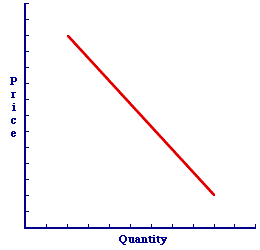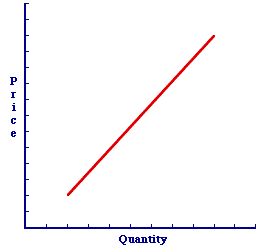
|
|
EURO: The denomination of the so-called single currency that is designed to integrate economic and monetary policies for the European Union. The euro will contain paper currency (banknotes) and metal coins and will replace the European Currency Unit that is presently used for commercial and financial transactions. While that plans are to introduce this single currency with paper and coins in 2002, no one knows for sure if the euro will completely replace national currencies (British pound, French franc, etc.) for transactions within each nation. The paper currency will come in denominations of 5, 10, 20, 50, 100, 200, and 500 euros and the metal coins will come in denominations of 1, 2, 5, 10, 20, and 50 cents, as well as 1 euro and 2 euros.
Visit the GLOSS*arama
|
|


|

|
                           SUBSTITUTE GOOD: In general, one of two (or more) goods that are related in an either/or fashion. In terms of demand, substitute goods are those that provide the same basic satisfaction of a want or need when consumed. In terms of supply, substitute goods are those that use the same resource for production in an exclusionary manner. A substitute good is one of two ways that goods are related. The other is a complement good. Goods can be substitutes in terms of consumption or production.- Substitutes-in-Consumption: Two or more goods that satisfy the same wants or needs. Consuming one good means that buyers have no need to consume another.
- Substitutes-in-Production: Two or more goods that can be produced using the same resources. Producing one good prevents sellers from using resources to produce another.
On the Consumption SideBuyers are frequently faced with the decision to purchase one good or another. Each good provides the same basic satisfaction of wants and needs. Buy one or buy the other, but not both.The need for food can be satisfied by consuming pizza or fried chicken. The need for transportation can be satisfied by buying a sport utility vehicle or a motorcycle. The desire for entertainment can be satisfied by watching a movie or attending a live theatrical performance. The price of a substitute-in-consumption is part of the other prices demand determinant. A change in the price of a substitute-in-consumption causes a change in demand and a shift of the demand curve. An increase in the price of one substitute good causes an increase in demand for the other. A decrease in the price of one substitute good causes a decrease in demand for the other. To illustrate this process consider two tasty substitute beverages--OmniCola and King Caffeine. Each provides comparable satisfaction to thirsty consumers. They buy one or they buy the other. | Substitute-in-Consumption |  |
How is the demand for OmniCola affected if the price of King Caffeine should change?- A Higher Price: Suppose the price of King Caffeine increases. Thirsty consumers making a beverage selection undoubtedly react according to the law of demand and decrease the quantity demanded of King Caffeine. However, in that consumers remain thirsty, they are bound to seek out a substitute beverage, such as OmniCola. The result is an increase in the demand for OmniCola and a rightward shift of the demand curve. Click the [Price Increase] button to demonstrate.
The beverage substitution between King Caffeine and OmniCola is due to a change in relative prices triggered by the change in the price of King Caffeine, given that the price of OmniCola remains constant. That is, even though the price of OmniCola does not change, it is relatively cheaper due to the higher price of King Caffeine.
- A Lower Price: Suppose the price of King Caffeine decreases. Thirsty consumers making a beverage selection now undoubtedly react according to the law of demand and increase the quantity demanded of King Caffeine. However, in that consumers are satisfying their thirst with King Caffeine, they are unlikely to buy as much of the substitute beverage, OmniCola. As such, the demand for OmniCola decreases and a leftward shift of the demand curve. Click the [Price Decrease] button to demonstrate.
The beverage substitution between King Caffeine and OmniCola is once again due to a change in relative prices triggered by the price of King Caffeine, with no change in the price of OmniCola. That is, even though the price of OmniCola does not change, it is relatively more expensive due to the lower price of King Caffeine.
On the Production SideSellers are frequently faced with the decision to produce one good or another using the same resources. Using the resources to produce one good prevents their use for production of the other. Produce one or produce the other, but not both.Farmers are frequently faced with the production of substitute crops, such as corn or soybeans. Automobile companies must choose between the production of four-door sedans or pickup trucks. Building contractors devote their resources to the construction of multi-family apartment buildings or single-family houses. The price of a substitute-in-production is part of the other prices supply determinant. A change in the price of a substitute-in-production causes a change in supply and a shift of the supply curve. An increase in the price of one substitute good causes a decrease in the supply of the other. A decrease in the price of one substitute good causes an increase in the supply of the other. To illustrate this process consider the production of two goods--sport shirts and window curtains. Each is produced using the same resources--workers, factories, tools, and materials. They produce one or they produce the other. | Substitute-in-Production |  |
How is the supply of sport shirts affected if the price of window curtains should change?- A Higher Price: Suppose the price of window curtains increases. Profit-minded window curtain producers undoubtedly react according to the law of supply and increase the quantity supplied of window curtains. However, in that this requires additional resources, fewer are available to produce a substitute good, such as sport shirts. The result is a decrease in the supply for sport shirts and a leftward shift of the supply curve. Click the [Price Increase] button to demonstrate.
The production substitution between window curtains and sport shirts is due to a change in relative prices triggered by the change in the price of window curtains, given that the price of sport shirts remains constant. That is, even though the price of sport shirts does not change, it is relatively cheaper due to the higher price of window curtains.
- A Lower Price: Suppose the price of window curtains decreases. Profit-minded window curtain producers now react according to the law of supply and decrease the quantity supplied of window curtains. However, this frees up resources that can be used to produce a substitute good, such as sport shirts. The result is an increase in the supply for sport shirts and a rightward shift of the supply curve. Click the [Price Decrease] button to demonstrate.
The production substitution between window curtains and sport shirts is once again due to a change in relative prices triggered by the price of window curtains, with no change in the price of sport shirts. That is, even though the price of sport shirts does not change, it is relatively more expensive due to the lower price of window curtains.

Recommended Citation:SUBSTITUTE GOOD, AmosWEB Encyclonomic WEB*pedia, http://www.AmosWEB.com, AmosWEB LLC, 2000-2024. [Accessed: October 30, 2024].
Check Out These Related Terms... | | | | | | | | | |
Or For A Little Background... | | | | | | | | | | | | | | | | | |
And For Further Study... | | | | | | | | | |
Search Again?
Back to the WEB*pedia
|



|

|
RED AGGRESSERINE
[What's This?]
Today, you are likely to spend a great deal of time flipping through the yellow pages wanting to buy either a large stuffed brown and white teddy bear or a replacement washer for your kitchen faucet. Be on the lookout for pencil sharpeners with an attitude.
Your Complete Scope
This isn't me! What am I?
|

|
|
The Dow Jones family of stock market price indexes began with a simple average of 11 stock prices in 1884.
|

|
|
"Anyone who has never made a mistake has never tried anything new. " -- Albert Einstein, physicist
|

|
IO
Industrial Organization
|

|
|
Tell us what you think about AmosWEB. Like what you see? Have suggestions for improvements? Let us know. Click the User Feedback link.
User Feedback
|


|


